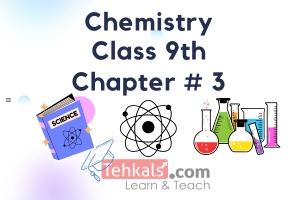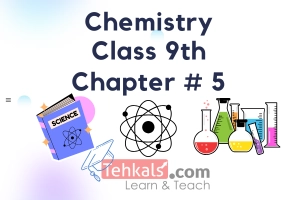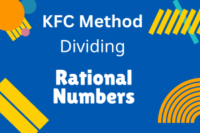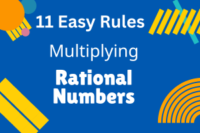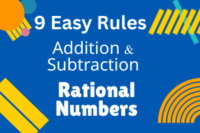Chemistry Class 9 Chapter 4
Published: 1 Oct 2023
Chemistry Class 9 Chapter 4 is about the “Structure of Molecules.” This article includes topics such as Chemical Bonding, Types of Bonds, Ionic Bond, Covalent Bond, Types of Covalent Bond, Co-ordinate Covalent Bond, Polar and Non-Polar Covalent Bond, Metallic Bond, Shapes of Molecules, Intermolecular Forces, Dipole-Dipole Interaction, Hydrogen Bonding, Properties of Ionic, Properties of Covalent and Properties of Metals.
Chemistry Class 9 Chapter 4 Notes
Structure of Molecules
Chemistry Class 9 Chapter 4-MCQs
Chemical Bond
Types of Bonds
1. The attractive force which keeps the atom _______ in a substance is called bond.(a) Together
(b) Separate
(c) In shift
Show Answer
Together
2. All elements and compounds are formed by the combination of atoms except the _______
(a) Hydrocarbon
(b) Noble gases
(c) Isotopes
Show Answer
Noble gases
3. ________ combine with one another by chemical process is called chemical bonding.
(a) Atoms
(b) Elements
(c) Compounds
Show Answer
Atoms
4. Every system in universe tends to lower its energy to attain ________
(a) Reactivity
(b) Molarity
(c) Stability
Show Answer
Stability
5. Atoms also have the tendency to ________ their energy.
(a) Increase
(b) Decrease
(c) Unchanged
Show Answer
Decrease
6. The combination of atoms gives stable molecule through emission of ________
(a) Energy
(b) Gases
(c) Particles
Show Answer
Energy
7. In 1916 , G.N Lewis and _____proposed the electronic theory of valance .
(a) Max plank
(b) W.Kossel
(c) Schrodinger
Show Answer
W.Kossel
8. The valance concept states that, in a chemical bond formation , atoms take part by losing , gaining or sharing of electrons to attain noble gas _______
(a) Stability
(b) Reactivity
(c) Electronic configuration
Show Answer
Electronic configuration
9. When atoms have two or eight electrons in their valance shell , they are ______
(a) Stable
(b) Reactive
(c) Unstable
(d) Non-reactive
Show Answer
Stable
10. The tendency of atom to attain ______ electrons in valance shell to attain stability is called octet theory .
(a) Eight
(b) Two
(c) Ten
Show Answer
Eight
11. By gaining two electrons from other atom, oxygen will complete its _____ and become stable.
(a) Duplet
(b) Triplet
(c) Octet
Show Answer
Octet
12. The tendency of atom to attain _______ electrons in its valence shell to attain stability is called duplet theory .
(a) Eight
(b) Two
(c) Ten
Show Answer
Two
13. ____ has two electrons in its valence shell and it is stable.
(a) Helium
(b) Lithium
(c) Thorium
Show Answer
Helium
14. Elements of Group-VIII are called ____ gases .
(a) Alkali
(b) Noble
(c) Halogens
Show Answer
Noble
15. Elements of Group-VIII are very stable and ______ take part in chemical reaction to form compounds.
(a) Commonly
(b) Every time
(c) Rarely
Show Answer
Rarely
16. The orbital concept is based on combination of atomic ______ to produce molecular orbital.
(a) Orbital
(b) Shells
(c) Ions
Show Answer
Orbital
17. The atomic orbitals have only ______ electron.
(a) 3
(b) 1
(c) 2
(d) 4
Show Answer
1
18. Endwise overlapping produce _____ bond.
(a) Pi
(b) Ionic
(c) Sigma
(d) None of these
Show Answer
Sigma
19. Sidewise overlapping produce _______ bond.
(a) Pi
(b) Ionic
(c) Sigma
(d) None of these
Show Answer
Pi
20. The attractive force which hold the atom together to form a molecule is called _______
(a) Overlapping
(b) Turbidity
(c) Bond
(d) None of these
Show Answer
Bond
21. There are the ______ main types of bond .
(a) 3
(b) 4
(c) 5
(d) 6
Show Answer
4
Ionic Bond
22. The chemical bond which is formed due to the ________ transfer of electron from one atom to another is called ionic bond.(a) Complete
(b) Partial
(c) Sharing
(d) None of these
Show Answer
Complete
23. Ionic bond is also called _____ bond.
(a) Dative
(b) Polar
(c) Electrovalent
(d) None of these
Show Answer
Electrovalent
24. The transfer of _____ between atoms complete the octets and duplets.
(a) Protons
(b) Electrons
(c) Neutrons
(d) None of these
Show Answer
Electrons
25. Metals always ____ electron to form cations.
(a) Lose
(b) Gain
(c) Share
(d) None of these
Show Answer
Lose
26. Non-metals always ____ electron to form anions
(a) Lose
(b) Gain
(c) Share
(d) None of these
Show Answer
Gain
27. In _______ bond formation, one atom lose electron and the other gains it .
(a) Covalent
(b) Metallic
(c) Ionic
(d) None of these
Show Answer
Ionic
28. The atom that loses an electron acquires _____ charge .
(a) Positive
(b) Negative
(c) Neutral
(d) None of these
Show Answer
Positive
29. The atom that gains electron acquires ____ charge .
(a) Positive
(b) Negative
(c) Neutral
(d) None of these
Show Answer
Negative
30. Due to opposite charges, the ____ force of attraction is set up between the two ions which hold them together.
(a) Electrostatic
(b) Magnetic
(c) London dispersion
(d) None of these
Show Answer
Electrostatic
31. The example of ionic bond is :
(a) $ H_2 $
(b) $ F_2 $
(c) $ Cl_2 $
(d) $ NaCl $
Show Answer
NaCl
Covalent Bond
Types of Covalent Bond
32. A bond formed when two atoms joined together by _____ of electrons is called covalent bond.(a) Gaining
(b) Sharing
(c) Losing
(d) None of these
Show Answer
Sharing
33. Covalent bonds are formed between two _____ elements .
(a) Non-metallic
(b) Metallic
(c) Flammable
(d) None of these
Show Answer
Non-metallic
34. Lewis proposed that two atoms attain _____ electronic configuration by sharing electrons between them.
(a) Unstable
(b) Stable
(c) Unreactive
(d) None of these
Show Answer
Stable
35. The shared pair of electrons between two bonded atoms are called ______ electrons.
(a) Localized
(b) Delocalized
(c) Shared
(d) None of these
Show Answer
Localized
36. All are the examples of covalent bond EXCEPT
(a) $ HCl $
(b) $ NaCl $
(c) $ H_2 $
(d) $ O_2 $
Show Answer
NaCl
37. The bond in which two atoms share ______ electron each to form a pair of electron is called single covalent bond
(a) One
(b) Two
(c) Three
(d) Four
Show Answer
One
38. A single straight line ______ shows single covalent bond.
(a) $ – $
(b) $ = $
(c) $ ≡ $
(d) None of these
Show Answer
$ – $
39. ____ is the example of single covalent bond .
(a) $ NaCl $
(b) $ CH_4 $
(c) $ O_2 $
(d) None of these
Show Answer
$ CH_4 $
40 The bond in which two atoms share ________ electrons is each to form two pair of electrons called double covalent bond
(a) Single
(b) Two
(c) Three
(d) None of these
Show Answer
Two
41. A double straight line________ shows double covalent bond .
(a) $ – $
(b) $ = $
(c) $ ≡ $
(d) None of these
Show Answer
$ = $
42. All are the example of double covalent bond EXCEPT :
(a) $ O_2 $
(b) $ C_2H_4 $
(c) $ CO_2 $
(d) $ F_2 $
Show Answer
$ F_2 $
43. The bond in which two atoms share_______ electrons to form three pairs of electrons is called triple covalent bond
(a) One
(b) Two
(c) Three
(d) None of these
Show Answer
Three
44. A triple straight line shows a covalent bond in which total of _____ electrons are shared.
(a) 3
(b) 6
(c) 9
(d) 12
Show Answer
6
45. The example of triple covalent bond is :
(a) $ N_2 $
(b) $ C_2 H_4 $
(c) $ CO_2 $
(d) None of these
Show Answer
$ N_2 $
46. The atomic number of Nitrogen is ________
(a) 9
(b) 7
(c) 5
(d) 3
Show Answer
7
47. Nitrogen has five ____ in its valence shell
(a) Neutron
(b) Protons
(c) Electron
(d) None of these
Show Answer
Electron
Co-Ordinate Covalent Bond or Dative Bond
48. The covalent bond in which only one atom donate the _______ of electron is called coordinate covalent bond .(a) Shared pair
(b) Lone pair
(c) Bond pair
(d) None of these
Show Answer
Shared pair
49. Coordinate covalent bond is also called _____ bond.
(a) Electrovalent
(b) Dative
(c) Polar
(d) None of these
Show Answer
Dative
50. The atom which donate the shared pair of electron is called ______
(a) Donor
(b) Accepter
(c) giver
(d) None of these
Show Answer
Donor
51. The atom which accept the shared pair of electron is called _______
(a) Donor
(b) Accepter
(c) Gainer
(d) None of these
Show Answer
Accepter
52. Which arrow represents coordinate covalent bond ?
(a) $ ⇌ $
(b) $ = $
(c) $ ≡ $
(d) $ → $
Show Answer
$ → $
53. The example of coordinate covalent bond is
(a) $ NH_4 $
(b) $ CH_3 $
(c) $ C_2H_2 $
(d) $ CO_2 $
Show Answer
$ NH_4 $
To Download Complete Notes of Class 9 Chemistry Notes, Click the link.
Non-Polar Covalent Bond
54. The covalent bond formed by mutual sharing of electrons between atoms, having similar ____ is called non-polar covalent bond.(a) Electron affinity
(b) Electronegativity
(c) Hybridization
(d) None of these
Show Answer
Electronegativity
55. All are the example of non-polar covalent bond except :
(a) $ HCl $
(b) $ H_2 $
(c) $ Br_2 $
(d) $ Cl_2 $
Show Answer
HCl
Polar Covalent Bond
56. The covalent bond formed by mutual _____ if electrons between atoms , having different electro negativities is called polar covalent bond(a) Gaining
(b) Losing
(c) Sharing
(d) None of these
Show Answer
Sharing
57. Following are the examples of polar covalent bond except :
(a) $ H_2 $
(b) $ HCl $
(c) $ H_2O $
(d) $ NH_3 $
Show Answer
$ H_2 $
Metallic Bond
58. The metals are formed formed from ____(a) Elements
(b) Compounds
(c) Molecule
(d) Atoms
Show Answer
Atoms
59. The atoms in metallic solids are bonded _____ to each other.
(a) Loosely
(b) Tightly
(c) Partially
(d) None
Show Answer
Tightly
60 The chemical bonding that result from the attraction between metal positive ions and the surrounding sea of electrons is called _______ bonding
(a) Metallic
(b) Ionic
(c) Covalent
(d) Dative
Show Answer
Metallic
61 Atoms in metals are bonded with each other in such a way that every atom is attracted from _____ by other atom
(a) Two sides
(b) Back and forth
(c) All sides
(d) None of these
Show Answer
All sides
Shapes of Molecules
62. Molecules are extremely _____ in size.(a) Large
(b) Small
(c) Intermediate
(d) None of these
Show Answer
Small
63. Scientists proved with the experiments that _____ of molecules are linear, triangular, tetrahedral and pyramidal etc
(a) Shapes
(b) Properties
(c) Applications
(d) None of these
Show Answer
Shapes
64. The molecular shape of $ CO_2 $ is ____
(a) Trigonal planner
(b) Angular
(c) Linear
(d) None of these
Show Answer
Linear
65. The molecular shape of $ H_2O $ is _____
(a) Trigonal planner
(b) Angular
(c) Linear
(d) None of these
Show Answer
Angular
66. The molecular shape of $ NH_3 $ is ______
(a) Trigonal pyramidal
(b) Triangular
(c) Tetrahedral
(d) None of these
Show Answer
Trigonal pyramidal
67. The angle inn linear shape of $ CO_2 $ molecule is :
(a) $ 104.5^0 $
(b) $ 180^0 $
(c) $ 109.5^0 $
(d) None of these
Show Answer
$ 180^0 $
Intermolecular Forces
68. The force of attraction between _____ of a compound is called intermolecular force.(a) molecules
(b) Atoms
(c) Elements
(d) None
Show Answer
molecules
69. The angle in bent shape of H2O molecule is :
(a) $ 104.5^0 $
(b) $ 180^0 $
(c) $ 109.5^0 $
(d) None of these
Show Answer
$ 104.5^0 $
70. Intermolecular force are ______ times weaker than covalent bond.
(a) 15
(b) 25
(c) 30
(d) 20
Show Answer
25
71. The intermolecular force are of three types collectively called as _____ force
(a) Sub-atomic particle
(b) Van der waals
(c) Sedimentation
(d) None of these
Show Answer
Van der waals
Dipole-Dipole Interaction
72. The attractive forces between positive pole of one polar molecule and negative pole of other polar molecule are called _______ interaction(a) Dipole – dipole
(b) London dispersion
(c) Hydrogen bonding
(d) None of these
Show Answer
Dipole – dipole
73. Polar covalent molecules are described as _______
(a) Diatomic
(b) Dipoles
(c) Polyatomic
(d) None of these
Show Answer
Dipoles
74. All are the examples of dipole-dipole interaction except:
(a) $ CO $
(b) $ HCl $
(c) $ H_2S $
(d) $ Hg $
Show Answer
$ Hg $
75. To break the dipole-dipole interaction in HCl molecules , it requires _____ energy
(a) $ 3.3 kj /mol $
(b) $ 3.3 A^0 $
(c) $ 3.3 Hz $
(d) $ 3.3 joules $
Show Answer
$ 3.3 kj /mol $
76. Hydrogen chloride (HCl) boils at ________
(a) $ 85^0 C $
(b) $ -85^0 C $
(c) $ 100^0 C $
(d) $ 63^0 C $
Show Answer
$ -85^0 C $
Hydrogen Bonding
77. The attractive force between highly electron deficient hydrogen atom and nearby highly electronegative atom with lone pair of electrons is called_______(a) Dipole-dipole
(b) Hydrogen bonding
(c) None
Show Answer
Hydrogen bonding
78. Hydrogen bond is _____ than dipole–dipole forces.
(a) Stronger
(b) Same
(c) Weaker
(d) None of these
Show Answer
Stronger
79. Hydrogen bond is ___________ than covalent bond.
(a) Stronger
(b) Same
(c) Weaker
(d) None of these
Show Answer
Weaker
80. Hydrogen bond is _____ times weaker than covalent bond
(a) 15
(b) 20
(c) 25
(d) 30
Show Answer
20
81. Hydrogen bond is _______ time stronger than dipole-dipole interaction
(a) 10
(b) 12
(c) 14
(d) 15
Show Answer
10
82. Hydrogen bond is _______
(a) Non-directional
(b) Directional
(c) Both
(d) None
Show Answer
Directional
Properties of Ionic Compounds
83. Ionic compound are _____ at room temperature .(a) Gas
(b) Liquid
(c) Solid
(d) Plasma
Show Answer
Solid
84. Ionic compounds have sharp _____ points
(a) Melting
(b) Boiling
(c) Freezing
(d) Both a and b
Show Answer
Both a and b
85. Ionic compounds are ____ in polar solvents like water.
(a) Soluble
(b) Insoluble
(c) Semi – soluble
(d) None of these
Show Answer
Soluble
86. Ionic compounds are ______ in molten or solution form.
(a) Strong electrolytes
(b) Weak electrolytes
(c) Non-electrolytes
(d) None of these
Show Answer
Strong electrolytes
Properties of Covalent Compounds
87. Covalent compounds have ______ melting and boiling points .(a) High
(b) Constant
(c) Low
(d) None of these
Show Answer
Low
88. Covalent compounds are ______ in solution form.
(a) Strong electrolyte
(b) Non – electrolytes
(c) Weak electrolytes
(d) None of these
Show Answer
Non – electrolytes
89. The bond in ________ compounds are directional .
(a) Covalent
(b) Ionic
(c) Metallic
(d) None of these
Show Answer
Covalent
90. Covalent compounds depends upon
(a) Geometry
(b) Polarity
(c) Bond types
(d) All of them
Show Answer
All of them
Properties of Metals
91. All metal are solid at room temperature and pressure EXCEPT :(a) Gold
(b) Mercury
(c) Aluminums
(d) None of these
Show Answer
Mercury
92. The property of metals in which they can beaten into sheets and foils are called _____
(a) Malleability
(b) Ductility
(c) Lustrous
(d) None of these
Show Answer
Malleability
93. Metals are __________ they can be drawn into wires.
(a) Covalent
(b) Ductile
(c) Ionic
(d) Non- conduction
Show Answer
Ductile
94. Metal are also ______
(a) Lustrous
(b) Sonorous
(c) Good conductor
(d) All of them
Show Answer
All of them
Review Exercise Chapter 4
1. An atom with a charge is called :(a) An electron
(b) A molecule
(c) A metal
(d) An ion
Show Answer
An ion
2. An elements X is in group VI of the periodic table. The ion will be represented by :
(a) $ X^+ $
(b) $ X^- $
(c) $ X^{-2} $
(d) $ X^{+2} $
Show Answer
$ X^{-2} $
3. Which pair of elements will join to form a compound with one to one ratio :
(a) Magnesium and chlorine
(b) Sodium and oxygen
(c) Potassium and fluorine
(d) Lithium and Sulphur
Show Answer
Potassium and fluorine
4. When calcium atom become a calcium ion $ (Ca^{+2}) $:
(a) It loses an electron
(b) It loses two electron
(c) It gains electron
(d) Gain two electrons
Show Answer
It loses two electron
5. Which two elements will form a covalent compounds :
(a) Sodium and oxygen
(b) Copper and oxygen
(c) Carbon and Oxygen
(d) Magnesium and Oxygen
Show Answer
Magnesium and Oxygen
6. In the formation of ionic bond, the atoms taking part :
(a) Only gain electrons
(b) Share electrons
(c) Lose and gain of electron
(d) Only lose electrons
Show Answer
Lose and gain of electron
7. Fluorine has an electronic configuration 2, 7 and Oxygen 2, 6. The formula of fluorine oxide will be :
(a) $ FO $
(b) $ F_2O $
(c) $ FO_2 $
(d) $ F_2O_2 $
Show Answer
$ F_2O $
8. Which of these statements about covalent bonds in incorrect :
(a) HCl contain one pair of shared electrons
(b) CCl_4 contain four pairs of shared electrons
(c) H_2O contain three pairs of shared electrons
(d) NH_3 contains three pairs of shared electrons
Show Answer
H_2O contain three pairs of shared electrons
9. Which of the following ions do not have the electronic configuration of an argon atom?
(a) $ Ca^{+2} $
(b) $ S^{-2} $
(c) $ K^+ $
(d) $ O^{-2} $
Show Answer
$ O^{-2} $
10. Which one of the groups below contains only ionic compounds?
(a) Calcium oxide, Hydrogen oxide Chlorine, Magnesium oxide
(b) Calcium oxide , magnesium oxide, sodium chloride
(c) Carbon dioxide , Copper sulphate ,Hydrogen Chloride
(d) Copper sulphate, methane , sodium chloride
Show Answer
Calcium oxide , magnesium oxide, sodium chloride
Chemistry Class 9 MCQs (All Chapters)

- Be Respectful
- Stay Relevant
- Stay Positive
- True Feedback
- Encourage Discussion
- Avoid Spamming
- No Fake News
- Don't Copy-Paste
- No Personal Attacks



- Be Respectful
- Stay Relevant
- Stay Positive
- True Feedback
- Encourage Discussion
- Avoid Spamming
- No Fake News
- Don't Copy-Paste
- No Personal Attacks
